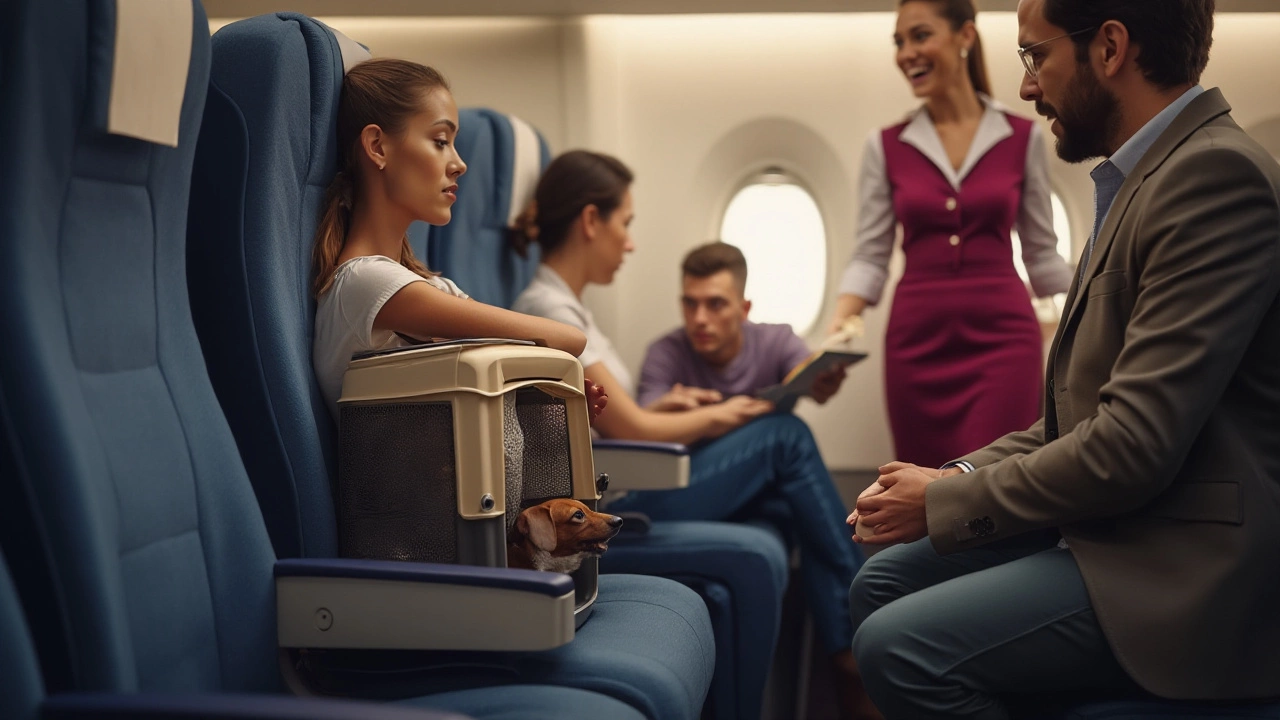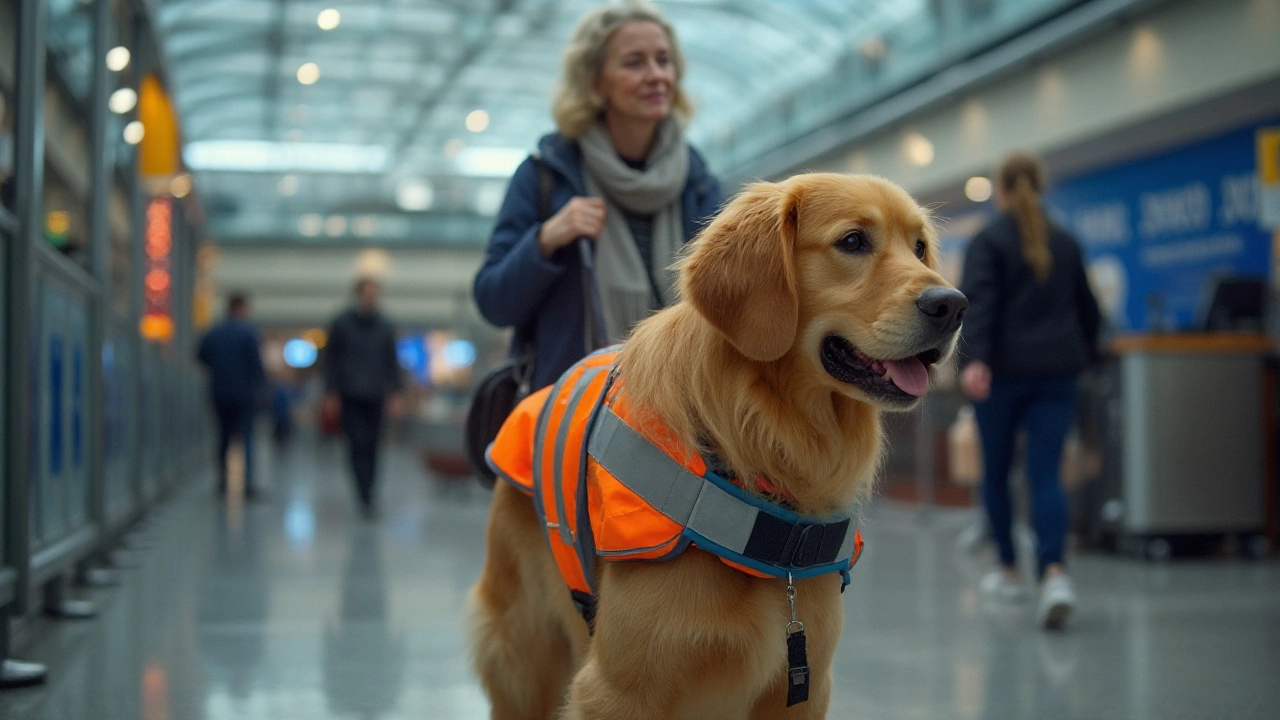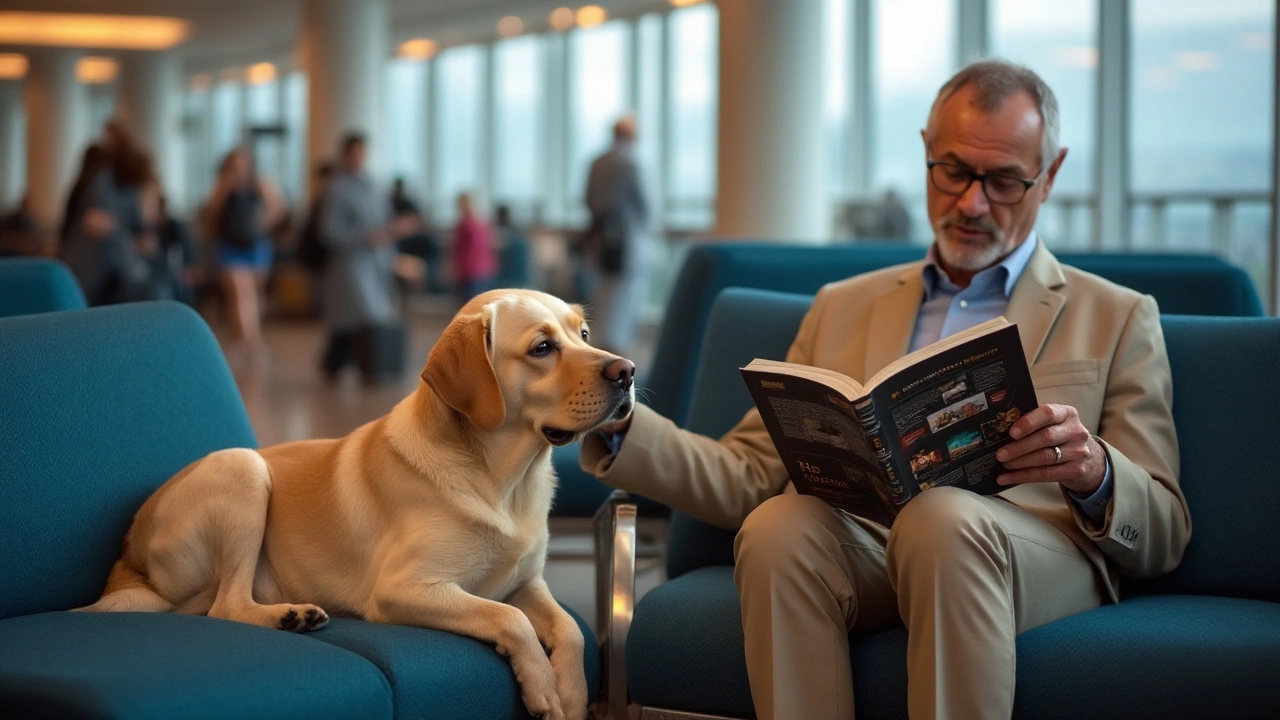Flying with your dog can bring a mix of excitement and anxiety, both for you and your four-legged friend. Pet travel has become increasingly common, and while many airlines offer pet-friendly options, the decision to take your dog on a flight is not one to be taken lightly.
Think about it: the bustling airport, the confined cabin, the unfamiliar noises—these factors can turn a pleasant trip into a challenging one. It's important to weigh the comforts and stresses air travel might impose on your pet. Before you buckle your dog's seatbelt into the plane, consider the insights and suggestions we've gathered to help you navigate this pet travel adventure smoothly.
- Understanding Airline Pet Policies
- Dog Breeds and Flight Suitability
- Preparing Your Dog for Air Travel
- Safety Measures During the Flight
- Alternatives to Flying with Your Dog
- Post-flight Care and Adjustment
Understanding Airline Pet Policies
Navigating airline pet policies can feel like stepping into an elaborate maze. Each airline has its own set of rules, and knowing these is paramount if you plan to fly with your pet. Policies can vary significantly from one carrier to another, affecting everything from the cost and type of carrier required to health documentation needed. Some airlines, for instance, allow small dogs to travel in the cabin if they weigh under a certain limit, often around 15 pounds, and are placed in a soft-sided carrier that fits under the seat in front of you. This can offer your pet more comfort and stability than the cargo hold.
Interestingly, there is a renaissance of sorts happening with pet travel as some airlines have begun introducing pet-friendly programs. These often permit small dogs to fly in the cabin and even offer essential amenities like pet relief areas at major airports. A few airlines regard the passenger’s desire to travel with dogs so significant that they have initiated frequent flyer programs for pets! However, for larger dogs, things can become a bit more complicated. They usually have to be transported as cargo, a term which can itself send shivers down the spine of any loving pet parent. This option can be stressful for dogs due to the separation from their owners and the noisier, colder environment of the cargo hold.
To give your pooch the smoothest experience possible, look into what airlines are doing in terms of climate control and lighting in the cargo area. Ask airlines about feeding and watering during flight delays or layovers, as some, like Lufthansa, even offer complimentary pet kits. Keep in mind that some breeds, especially those with flat noses like Bulldogs, may face additional travel restrictions due to their increased risk of breathing issues. Don't forget, each airline's pet policy can be distinctly different from the next, and knowing this can prevent any unwanted surprises at the gate or worse, having to leave your pet behind.
"Before booking a flight, check not only what the airline website says but also call their customer service to verify policies, as they may differ by small yet crucial details," suggests Dr. Linda Simon, a renowned veterinarian in Auckland.
Ensuring your pet is healthy enough to fly is another crucial aspect in meeting airline pet policies. Most airlines require a recent health certificate from a veterinarian, typically issued within 10 days of travel. This document must affirm that the pet is vaccinated and free from infectious diseases. Importantly, airlines will often need additional documentation for international travel, such as an import permit or proof of rabies vaccination, depending on the destination. This can be a cumbersome process involving multiple forms at times, especially considering that there might be a statutory quarantine period at certain destinations.
Do not underestimate the value of reading reviews and personal accounts from pet owners who have flown with the same airline. These insights can offer understanding from a first-hand perspective about how well an airline typically handles pet passengers. Taking time to read such accounts could offer valuable tips and perhaps even make your decision easier when faced with the choice between several airlines. Remember, feeling well-informed about pet travel policies will help ensure that the journey is as smooth for your canine companion as it is for you, setting the stage for an adventure that both of you will cherish.
Dog Breeds and Flight Suitability
Not all dog breeds are made equal when it comes to handling the rigors of air travel. Some breeds adapt well to the travel experience, while others may find it stressful or even dangerous. Understanding the suitability of your dog’s breed for airplane travel is crucial. Large dogs, such as Great Danes, might find airplane cabins uncomfortable due to space constraints, while small dogs, like Chihuahuas, can often fit under seats, making them more airline-friendly. Consider the physiology and temperament of your furry companion when making travel plans. It's no surprise that some airlines have restrictions on certain breeds due to health considerations, particularly brachycephalic, or flat-faced breeds, such as Bulldogs and Pugs. These breeds can suffer from respiratory issues, particularly in high-stress and low-pressure environments.
Health risks aren't the only concern. The personality and comfort level of your dog are just as important. Certain breeds are naturally more anxious than others, potentially exacerbating the stress of travel. Social breeds like Golden Retrievers might handle the trip better due to their adaptability and social nature. On the other hand, dogs that are prone to anxiety may experience an unpleasant journey, affecting their well-being. A key to a successful flight is thorough planning and understanding your dog's specific needs, ensuring they are met throughout the process. Doing so can make the journey as pleasant as possible for both you and your companion.
It's also helpful to be aware of the specific regulations and guidelines provided by different airlines regarding breed limitations. While many airlines have adjusted their policies to accommodate traveling pets better, some remain stringent due to previous incidents or safety protocols. Consulting with a professional, like a veterinarian, can provide invaluable advice tailored to your dog’s physiological and psychological makeup.
| Breed | Travel Suitability | Special Considerations |
|---|---|---|
| Labrador Retriever | High | Needs exercise before flight |
| French Bulldog | Low | Not recommended due to respiratory issues |
| Poodle | Moderate | Ensure calming aids available |
Recognizing the best approach for *flying with dogs* requires balancing their physical and emotional needs with realistic travel options. Preparing for this requires more than just a plane ticket; it involves understanding your dog’s unique character, health, and comfort level. As you plan your next trip, keep in mind that your journey's success largely hangs on your preparedness and willingness to adapt to your dog's *travel* needs.

Preparing Your Dog for Air Travel
Embarking on a journey with your dog in tow requires more than just booking a ticket. The crux of a smooth flying experience starts well before you even step into the airport. Dogs, much like us, are creatures of habit and comfort, so taking time to mentally and physically prepare them for air travel is pivotal. Begin by ensuring you have a thorough understanding of airline pet policies to avoid any unpleasant surprises at the last minute. Check if your dog fits the suitability criteria for air travel as some airlines have restrictions on certain breeds. Research and select a suitable pet carrier that is both comfortable for your dog and compliant with airline regulations.
To ease anxiety, especially for dogs unfamiliar with confinement, let your pet get accustomed to their carrier well ahead of the trip. Place the carrier in their favorite part of the house and encourage positive associations with it by tossing treats or toys inside. It's not uncommon to see dogs benefiting from short car trips in their carriers to simulate the idea of travel. According to Dr. Janet Thorne, a veterinarian from the American Pet Owners Association, "Enabling dogs to familiarise with their immediate travel environment significantly reduces the initial stress during travel," she shares.
Remember, pre-boarding veterinary checks are not just a formality but an assurance for a safer journey. Visit your vet a few weeks before your planned flight to ensure your dog is in good health and up to date with vaccinations. Consider getting a health certificate if it's needed for the destination or airline. Speak with your vet about any concerns you might have regarding travel anxiety, as they may recommend solutions like natural supplements or mild sedatives.
Advance planning also means adhering to a thoughtful schedule in the days leading up to your flight. Gradually adjusting your dog’s feeding and bathroom routine to align with the time zone changes of your destination can help minimize any disruption. It’s wise to feed your dog a light meal a few hours prior to flying to avoid motion sickness. Expert trainers often suggest emotional bonding exercises like brisk walks or play sessions before heading to the airport. This could significantly help expend excess energy, allowing your dog to settle more easily during the flight.
Consider creating a checklist to ensure all bases are covered. Essential items include your dog's favorite toys, a blanket with a familiar scent, and any necessary medications. Label everything clearly with your contact info just in case. As busy as it may get while organizing the trip, don’t forget that your calmness and reassurance can strongly influence your dog's traveling demeanor. Every long journey is made up of little steps, and similarly, ensuring a hassle-free air travel with pets begins with thoughtful preparation.
Safety Measures During the Flight
When it comes to ensuring the safety of your beloved pooch during a flight, preparation is key. Air travel can be a surprising mix of unpredictabilities, and being prepared for those twists and turns is essential. One of the first steps is checking whether your dog is healthy enough to fly. It's a good idea to consult your veterinarian; certain health conditions may make flying risky for your dog. Ensuring that your furry companion is up-to-date with their vaccinations and carrying a health certificate is often required by airlines. It's not just the flight itself but the air pressure changes that can potentially affect your dog's health, so take this precaution seriously. Once you've ensured your dog's health is in check, it's time to choose the right carrier that complies with the airline's regulations. A properly sized carrier, where your dog can sit, stand, and turn around comfortably is crucial—not just for their comfort, but also for their safety.
Another important aspect of safety during the flight is making sure your dog is well-hydrated but not overly full. Before the flight, give them just enough water to stay hydrated, but avoid feeding them a heavy meal. The motion of the aircraft can be unsettling, and you don’t want to add to your pup's stress levels with a full stomach. Attach a small collapsible water dish to the door of their carrier, making it easy to provide water without disrupting your dog's sense of security. While it might be tempting to give your dog a sedative to help them relax during the flight, it is not advised unless prescribed by a vet.
“Sedating pets during air travel can increase the risk of respiratory and cardiovascular problems in flight,” warns the American Veterinary Medical Association.Instead, you might consider alternative products like calming collars or sprays, which can provide a sense of calm without hefty side effects.
Beyond the physical preparation, emotional preparation also plays a significant role in ensuring safety during the flight. Pet owners often overlook just how deeply pets can sense and absorb the emotional atmosphere around them. If you're relaxed, your dog is more likely to pick up on that and stay calm. Speak to them in soothing tones and offer them their favorite blanket or toy inside the carrier, something with familiar scents that remind them of home. During the flight, the environment in the cabin can sometimes be overwhelming for dogs due to temperature and pressure changes. Check with the airline staff to ensure the cargo hold, if that's where your dog will be traveling, is properly climate-controlled and pressurized. For smaller dogs that travel in the cabin with you, keep their carrier under the seat in front of you, ensuring that your pet can still see out to some extent, which can help keep them calm throughout the journey. Finally, keep an eye on them as much as feasibly possible. Recognizing signs of stress or discomfort quickly allows you to address any potential problems before they escalate. The aim is to make the journey as stress-free as possible for both you and your dog.

Alternatives to Flying with Your Dog
Deciding whether to fly your pooch to your destination can be tough, especially when you're unsure about how they'd handle the skies. The good news is there are other ways to get your furry friend from point A to point B without boarding a plane. When weighing these alternatives, think about your pet's personality, health, and your own travel needs. You may find that one of these options suits you both perfectly. Driving, for instance, is a popular choice among dog owners who enjoy taking road trips. Not only does it allow you to spend uninterrupted quality time with your pet, but it can also be less stressful for animals compared to flying. You’ll have full control over rest stops, where you can let your dog stretch its legs, enjoy the fresh air, and keep hydrated. Long drives might be tiring, but they can also strengthen your bond; just remember to pack all the necessary supplies, like water, food, and a comfortable harness. If driving isn't feasible or if the distance is simply too far, consider reaching out to pet transport services. These specialized businesses focus on safely delivering pets either by ground or air but with more controlled environments catered to animal needs. They often provide door-to-door service and let you track your pet’s journey, offering peace of mind.
"Safety and comfort should always be top priorities when transporting pets," says Sarah Ellis, a pet travel specialist. "Finding a service that understands and respects your pet’s unique needs can make all the difference."Another alternative involves planning pet-friendly train journeys. In regions where trains allow pets, this can be a delightful experience. Dogs get to enjoy being close to their owners without the turbulence of air travel, and you can both watch the world go by at a more leisurely pace. Different countries have varying policies on pets on trains, so it's worthwhile to check specific regulations well in advance of your trip.
If none of these travel options suit your itinerary, sometimes the best choice is to leave your dog in the care of a trusted friend or family member or to hire a reputable pet-sitting service. This helps avoid the travel ordeal entirely. Quality pet-sitting services provide daily updates, ensuring your pet feels safe and loved while you’re apart. Of course, this depends largely on the dog's temperament and trust levels with the caregiver, but for some, home is just where they’d rather stay while you tackle your wanderlust. Occasionally, statistics also portray that a substantial number of pet owners opt for pet relocation services each year, catering specifically to those relocating long distances while ensuring pet safety and comfort during the entire journey in ways you might not manage alone.
Post-flight Care and Adjustment
After the hustle and bustle of air travel, it’s time to focus on helping your furry friend settle into their new environment. The change in surroundings can be bewildering for dogs, especially if they are not frequent travelers. The first thing you should do is ensure they're given ample opportunity to stretch and roam. This allows them to shake off any lingering stress from the flight. Providing them with a familiar space, like a cozy bed or a favorite toy, can greatly ease the transition. It's essential to observe their behavior; dogs are remarkably expressive in communicating unease or discomfort.
Hydration is another crucial aspect that demands attention after air travel. The dry air in the cabin might leave your dog dehydrated, so offer them plenty of fresh water once you’ve landed. You might also notice a change in their appetite—don’t be alarmed if they don’t resume their usual eating routine immediately. Give them some time and offer small, light meals. Keeping a close eye on their digestion and bowel movements over the first few days can also help identify any issues that may have cropped up during the journey.
Engage your dog in physical activities to counter post-travel lethargy. Whether it’s a brisk walk or a playful game of fetch, exercise stimulates both their physical and mental health, helping them relocate their travel weary spirits. Regularity in their routine will also aid adjustment; try to maintain feeding times, walks, and playtime as you would back home. This consistency can be reassuring for your canine companion, providing a grounding familiarity amid new stimuli.
Finally, should you notice any unusual behavior or lasting signs of stress like excessive barking, whining, or hiding, a visit to a local vet could be wise. As the travel expert Mark Twain once said, "Explore. Dream. Discover." And the same can be said for your pooch on their new adventure. Don't fret over small hiccups; instead, cherish the memories you create together. Look out for that joyful tail wag, and you'll know they've settled right in.
